Jamie Malanowski's Blog, page 10
August 8, 2013
APPALACHIAN SUMMER: LEXINGTON, KY, AUGUST 2nd

Cara took us to a very stylish Mexican restaurant called Coba, which had a jellyfish tank, and where I proved incapable of ordering a fish taco.
APPALACHIAN SUMMER: PERRYVILLE, KY, AUGUST 1st
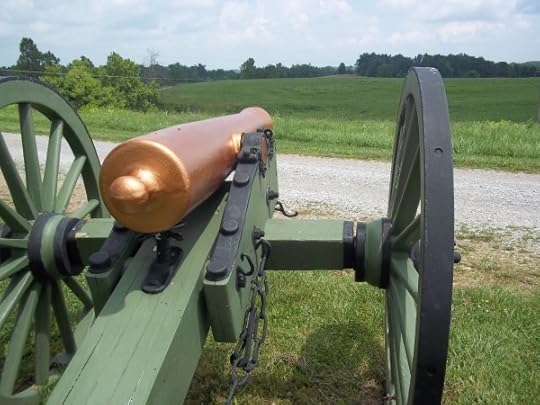 Given the size of the armies engaged, the Battle of Perryville, fought on October 8, 1862, was one of the bloodiest battles of the Civil War. Generally thought of as a confederate tactical victory but a Federal strategic victory–what that means is that after a ferocious, day-long the rebels forced the Yanks to withdraw from the field, but the weakened rebs then had to withdraw from Kentucky–the battle needs to be seen as a multi-pronged Confederate offensive (Antietam, fought three weeks earlier, was part of the overall campaign) that failed to throw the north on the defensive or to get it to capitulate. The Union retained control of the critical border state of Kentucky for the remainder of the war. As much as anything, the Kentucky campaign reveals Braxton Bragg’s weaknesses as a commander.
Given the size of the armies engaged, the Battle of Perryville, fought on October 8, 1862, was one of the bloodiest battles of the Civil War. Generally thought of as a confederate tactical victory but a Federal strategic victory–what that means is that after a ferocious, day-long the rebels forced the Yanks to withdraw from the field, but the weakened rebs then had to withdraw from Kentucky–the battle needs to be seen as a multi-pronged Confederate offensive (Antietam, fought three weeks earlier, was part of the overall campaign) that failed to throw the north on the defensive or to get it to capitulate. The Union retained control of the critical border state of Kentucky for the remainder of the war. As much as anything, the Kentucky campaign reveals Braxton Bragg’s weaknesses as a commander.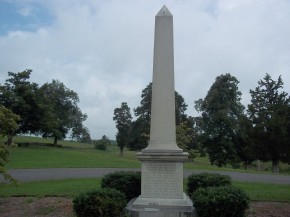
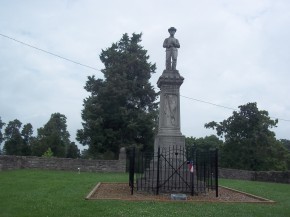
The gun at top was part of an Illinois battery commanded by a Captain Simonsen. The battery lost a quarter of its strength during the battle, and fired all of its ammunition, 795 shells, during the fighting. Above, monuments to the Union dead (left) and confederate (right). Note: The Malanowski Cannon Picture from Vacation Tradition continues!
August 7, 2013
APPALACHIAN SUMMER: LOUISVILLE, KY, JULY 31st
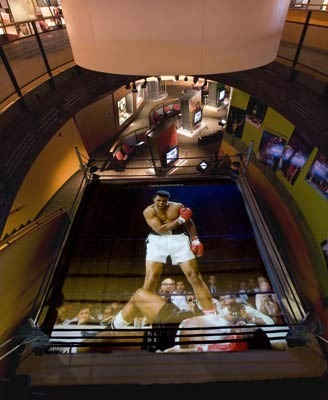 We really enjoyed visiting the Muhammad Ali Center in downtown Louisville. I was impressed how the center handled all
We really enjoyed visiting the Muhammad Ali Center in downtown Louisville. I was impressed how the center handled all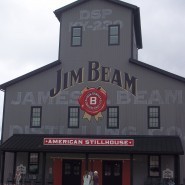 aspects of Ali’s career–boxer, activist, humanitarian–in a straightforward, warts-and-all manner. You hear him calling white people `devils’; you also hear him say that a 60 year old man who thinks the same things that he did when he was thirty has wasted thirty years. I also liked how they presented many fights by projecting them onto the mat of a full-size boxing ring (above). Later, after lunch, we drove to Bardstown and toured the Jim Beam distillery. The 90 minute tour was about 30 minutes too long, but at least I now know a little bit about why bourbon is bourbon and not whiskey or mash.
aspects of Ali’s career–boxer, activist, humanitarian–in a straightforward, warts-and-all manner. You hear him calling white people `devils’; you also hear him say that a 60 year old man who thinks the same things that he did when he was thirty has wasted thirty years. I also liked how they presented many fights by projecting them onto the mat of a full-size boxing ring (above). Later, after lunch, we drove to Bardstown and toured the Jim Beam distillery. The 90 minute tour was about 30 minutes too long, but at least I now know a little bit about why bourbon is bourbon and not whiskey or mash.
APPALACHIAN SUMMER: MAMMOTH CAVE, KY, JULY 30th
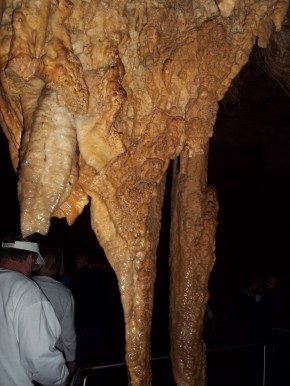
 Well, it was a cave, and it was mammoth. We took the short tour, and we were sated. Lots like this. The Park Ranger who guided the tour was very good. Later we visited Lincoln’s birthplace at Sinking Springs, most memorable for a majestic temple which contains a replica of the humble log cabin where Lincoln was born. Apparently, they have a humble cabin where some other bloke was born. Weird.
Well, it was a cave, and it was mammoth. We took the short tour, and we were sated. Lots like this. The Park Ranger who guided the tour was very good. Later we visited Lincoln’s birthplace at Sinking Springs, most memorable for a majestic temple which contains a replica of the humble log cabin where Lincoln was born. Apparently, they have a humble cabin where some other bloke was born. Weird.
APPALACHIAN SUMMER: MATEWAN, WVA, JULY 29th
 West Virginia, astonishingly vertical, rises like a wall nearly everywhere but right in front of you. The highways cut like ribbons through the hills, while below grade, little communities huddle in the hollers. We got off the highway and followed a thin road to Matewan (that’s MATE-wan), a coal and railroad town. Now kind of run down, it has a dramatic hertage of violence and tragedy: as the regional headquarters of Devil Anse Hatfield, of the Hatfied-McCoy feud (He does kind of resemble Kevin Costner!); as the site of
West Virginia, astonishingly vertical, rises like a wall nearly everywhere but right in front of you. The highways cut like ribbons through the hills, while below grade, little communities huddle in the hollers. We got off the highway and followed a thin road to Matewan (that’s MATE-wan), a coal and railroad town. Now kind of run down, it has a dramatic hertage of violence and tragedy: as the regional headquarters of Devil Anse Hatfield, of the Hatfied-McCoy feud (He does kind of resemble Kevin Costner!); as the site of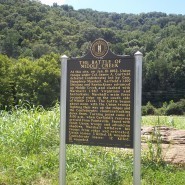 labor conflicts in
labor conflicts in  the 1920s, where cold-blooded shootings left unionists and goons dead in the street (I need to watch again the John Sayles movie); and after repeated
the 1920s, where cold-blooded shootings left unionists and goons dead in the street (I need to watch again the John Sayles movie); and after repeated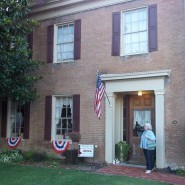 floodings of the benign-seeming Tug River, which flowed quietly during our visit, indolently separating us from Kentucky. The modest museum was highly informative. After lunch, we drove on, pausing at the site of the Battle of Middle River, KY, a January 1862 scrap in which the young James Garfield first distinguished himself, and put himself on the pathto the presidency. Not really much of a battle; 15 dead on both sides combined, which is about what you get at your average Bronx social club on a hot night Saturday night in August, but it helped keep Kentucky in the union. We spent the night a nice bed and breakfast in Glasgow, KY, where Abraham Lincoln once slept or had tea or something.
floodings of the benign-seeming Tug River, which flowed quietly during our visit, indolently separating us from Kentucky. The modest museum was highly informative. After lunch, we drove on, pausing at the site of the Battle of Middle River, KY, a January 1862 scrap in which the young James Garfield first distinguished himself, and put himself on the pathto the presidency. Not really much of a battle; 15 dead on both sides combined, which is about what you get at your average Bronx social club on a hot night Saturday night in August, but it helped keep Kentucky in the union. We spent the night a nice bed and breakfast in Glasgow, KY, where Abraham Lincoln once slept or had tea or something.
APPALACHIAN SUMMER: CHIEF LOGAN WVA, MONDAY, JULY 29th, 8:00 AM
August 5, 2013
ART DONOVAN, 1924-2013
Art Donovan, the exemplary defensive tackle of the great Baltimore Colt teams of the 1950s, died in Baltimore. Among his other distinguished accomplishments, he was the subject of one of my first articles, in Sports Illustrated:
Fans who tune in to Late Night With David Letterman get a special treat from time to time, when Art Donovan, a 60-year-old, 340-pound man with a severe crew cut, tells stories about his life in the National Football League. Those who remember Donovan’s career (1950-61), most of it as a defensive tackle with the Baltimore Colts, might expect the stories to be long on glory. After all, he played on two championship teams, was named All-Pro four times, played in five Pro Bowls and was elected to the Hall of Fame only six years after his retirement. But they would be wrong. Instead, Donovan tells tales of mayhem and mischief both on and off the field. And he is funny.
We had a quarterback named George Shaw. He wasn’t a very big guy, but he was a talented fella, a lot like Francis Tarkenton. Well, we were playing the Bears in ’55, and Dick Szymanski was the center. It was in the second quarter, and Shaw goes back to throw a pass, and just as he’s about to throw, a lineman breaks through and hits him. At the same time, a linebacker, George Connor, comes blitzing in with a 20-yard head start, and he hits George a shot. Jeez, he leveled him. He put a shoulder right in his face, busted the face mask. They pulled George off the held. His nose was bleeding, he didn’t know where he was. So he’s on the bench, and he says to Szymanski, “Hey, Szyzzie, how do my teeth look?” And Szyzzie says, “I don’t know, George, they aren’t there.”
Donovan had been a popular banquet speaker in Baltimore for years. In 1981 Steve Sabol of NFL Films caught his act and was fascinated. “We were doing a show on the NFL in the ’50s,” says Sabol, “and several people told me that Art Donovan was the man to see. Well, we went down to his country club in Baltimore, and he was great. When many people talk, it’s like watching a train of boxcars go by. But Artie tells stories that have a beginning, a middle and an end. We shot 12 rolls of film that day, more than we’ve shot with anybody. There was enough material for us to use in 10 programs.”
As it happened, Late Night producer Barry Sand saw one of those shows. “Art was outrageous, funny and definitely not normal,” he says. “It seemed to me that if he could be as funny in a talk show setting, he’d make a wonderful guest.” Did Sand realize what a great football player Donovan had been? “No, I had no idea,” he says. “Frankly, when I saw the crew cut I wondered if he was still alive.”
“In my first appearance,” Donovan says, “I was telling stories, and people were laughing, and everything was great. When we cut to a commercial, the guy says, ‘Can you do another eight minutes?’ I said, ‘Hell, I can do eight months.’ ”
Sure, football’s a rough game. When I was with Dallas, a guy jumped up and down on my leg until he broke it. It hurt like hell. I sat out two games, but then they didn’t have anybody else so they taped me up and put me in. I told them I couldn’t run. They said, “That’s O.K., if they run the play at you, just fall down and try to get in the way.”
Bill Pellington, the Colts’ middle linebacker, was a rough player. The Detroit Lions were out to get him, and a Lion fullback named Tracy broke Pellington’s arm in the first game of the ’57 season, forcing him out for the year. The next year, they let Pellington put a steel cast on his arm, wrapped in a quarter inch of foam rubber. Well, that’s as good as nothing. He was going around, swinging that arm, hitting people. Billy Howton, the wide receiver for the Packers, went up to the ref and said, “Hell, why don’t you give him a gun and let him do a clean job on us?”
Donovan’s storytelling abilities may make people forget just how good a player he was. Seeing little snippets of film doesn’t help. In the highlight film of the famous 1958 championship game, for example, the Giants’ big plays were run away from Donovan’s side, leaving the camera to record what appears to be a marshmallow wearing No. 70, shirt out, socks down, trotting after the play.
George Young, currently the general manager of the Giants, saw most of Donovan’s professional career, first as a fellow tackle on the Dallas Texans and then as a fan of the Colts and close friend (Young was an usher at Donovan’s wedding). ” Donovan wasn’t a very good player when he came into the league,” Young says. “He was a 25-year-old rookie who hadn’t been taught anything. It wasn’t until Weeb Ewbank became head coach in 1954 that Arthur developed.”
“I was lucky,” says Donovan. “If I had gone to any other team in the league when I broke in, in 1950, I wouldn’t have made it. But the Colts were the lousiest team in football, so I made the squad. But when Weeb came, he taught us that by concentrating on the movements of the three linemen in front of you, you can tell where the ball is going.”
Donovan prospered under that system. “He had great powers of concentration,” says Young. “Playing the line has more to do with feeling and reacting than with seeing, and Donovan was able to concentrate, recognize and react faster than anybody. He played low in what was then a high league, and he stuffed the trap all the time. If he got trapped once in five games, that was a lot.”
Young describes Donovan as an underrated pass rusher. “He was strong and agile, a good athlete for a fat guy. He was able to get that first step. For 10 yards he had good quickness. After that, he had calendar speed. Arthur wasn’t an impact player, but he seldom made a mistake. I remember him as a player who played perfect games. His consistency was his greatness.”
There were a lot of good offensive linemen in the league. I’d be very remiss if I pointed to one guy and said he was the toughest. But one who really had my number was Bruno Banducci, the right guard of the 49ers. About 6’1″, about 255, low center of gravity, the kind you have trouble with. I thought the guy was always holding, he was blocking me so well. Then I saw the movies, and he was just beating me. He played next to an All-America, a guy named Al Carapella, and that guy was just out-and-out holding me. I said, “Hey! Don’t hold me!” Well, the next time he held me, I hit him in the mouth, and I knocked two teeth out. I split my knuckle! He was hollering at me, and Banducci said to me, “What did you do that for?” I said, “He was holding me!” Banducci turns to the guy and says, “Serves you right. You don’t have to hold Donovan.”
We played the Giants in an exhibition game in Louisville. It was a brand-new stadium, and the first thing they had in there was a circus. Every time you put your hand down, you put it in a pile of elephant manure. That was O.K. During the game, after the offense set and the linemen couldn’t move, we’d throw globs of it at them.
Donovan was born in the Bronx. His grandfather, Mike O’Donovan, was a world middleweight boxing champion—and a frequent sparring partner of Theodore Roosevelt. His father, Arthur Donovan, a famous boxing referee, presided at 22 championship bouts, including 19 of Joe Louis’s. He was also the boxing instructor at the New York Athletic Club for 55 years. “My father was a big man in New York,” says Donovan. “He taught boxing to every millionaire in town. I was always known as Young Arthur or Little Arthur.” Donovan doesn’t make any more of it than that, but after becoming a hero in Baltimore he stayed there, growing in wisdom, age, grace…and weight.
“I don’t eat vegetables,” he says, explaining how he keeps his figure. “I only eat food like cheeseburgers, Spam, hot dogs and pizza. And I drink a little beer. People tell me if I don’t eat vegetables, I’m going to get scurvy. Well, what the hell. But I was never overweight as a player. There was a clause in my contract that said I had to weigh in at 270 every Friday morning. I always made it. I’d have dinner on Monday, and then I wouldn’t eat until Friday. I’m not saying I didn’t drink a little beer, but I wouldn’t eat. By Saturday I’d weigh 280.” Donovan says that Ordell Braase, a former teammate, recently cracked that if Richard Perry is called the Refrigerator, Donovan should have been called the Walk-in Freezer.
We were at training camp at Western Maryland College, and some of us older guys started wondering who was the biggest eater on the team. Well, three guys thought it was Gino Marchetti, and three of us thought it was Don Joyce, the other defensive end. So we put up $100 apiece, and after the coaches left, the eight of us went over to the cafeteria to have this contest. So the guy there puts out this beautiful meal of fried chicken, mashed potatoes and gravy and peas. Well, the bet was how many pieces of chicken these guys could eat. Gino just ate the chicken, but Joyce started eating the whole meal. I said, “For God’s sake, don’t worry about the mashed potatoes, just eat the damn chicken!” So he stopped, after two helpings. Well, Marchetti ate 26 pieces of chicken. Joyce hit 25, and we said, “Great, two more and we win.” But Joyce said, “Hold on, I’m still hungry.” He ended up eating 38 pieces of chicken. But the thing is, we hadn’t let him drink anything until he beat Gino, on account of we didn’t want his stomach to fill up. So when Joyce had his 27th piece of chicken, he said, “Man, I gotta wash this down.” There was a big pitcher of iced tea in front of him, so we said, “Here, have it.” With that, he takes four pieces of saccharin out of his pocket and puts them in the tea. He says, “I’m watching my weight.”
Donovan clearly relishes his current notoriety and enjoys trucking around the country, enlivening sports gatherings wherever he goes. “He likes people,” says Young, “and it shows. Plus, he knows how to laugh at himself.” People also like his honesty. “You hear announcers saying everybody’s a great football player, and everybody’s the most perfect guy in the world. They’re not. Some guys are lucky to be playing. And we had guys on our team who were trying to run their wives over in the driveway. Cut the crap.”
We were playing an exhibition game against Green Bay in Milwaukee, and a bunch of us were drinking in this bar. Most of us left, but Don Shula stayed there with Carl Taseff, a defensive back. We were back at the hotel for a little while, and the cops showed up. Uh-oh. They said, “We know one of you Colts stole a taxicab.” What happened is that Shula and Taseff honked the horn, but nobody showed up. So Shula put Taseff, who was loaded, in the back of the cab, and put the cabbie’s hat on, and drove back to the hotel. And you know, they never would have got caught, except Taseff was slow getting out of the cab. He wanted to pay Shula the fare.
Donovan hopes that the NFL will return to Baltimore. ” Robert Irsay ruined my Sundays,” he says. “I tell people Baltimore is lucky to be rid of the Colts, they’re so lousy, but I don’t mean it.” Temporarily, at least, Baltimore’s football fans have only stories to carry them. They’re lucky to have a Hall of Fame storyteller to listen to.
July 27, 2013
TALKING DISUNION IN MANHATTAN
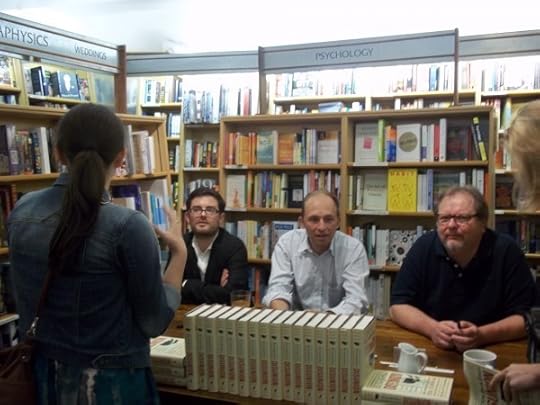 hanks to the folks at Jackson-McNally Bookstore in Soho for hosting a panel discussion by three of us who have been contributors to The New York Times‘ Disunion series, and to the new
hanks to the folks at Jackson-McNally Bookstore in Soho for hosting a panel discussion by three of us who have been contributors to The New York Times‘ Disunion series, and to the new 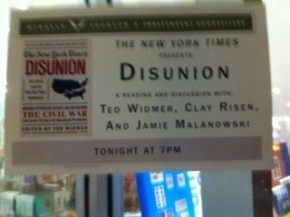 compilation of pieces from the series published by Black Dog & Levanthal. Clay Risen of the Times, Ted Widmer of Brown University, and yours truly met with about twenty people, and we had a fun and lively discussion. Most pleasant surprise: meeting a young lady who turned out to be a cadet from West Point who was doing a summer internship at The Wall Street Journal and who had written about Alonzo Cushing, and why he deserves the Medal of Honor.
compilation of pieces from the series published by Black Dog & Levanthal. Clay Risen of the Times, Ted Widmer of Brown University, and yours truly met with about twenty people, and we had a fun and lively discussion. Most pleasant surprise: meeting a young lady who turned out to be a cadet from West Point who was doing a summer internship at The Wall Street Journal and who had written about Alonzo Cushing, and why he deserves the Medal of Honor.
NULLIFICATION, SECESSION, AND NOW OBSTRUCTIONISM
One of the pitfalls in writing about the Civil War is the tendency to see things through a Civil War lens. As a result, one sometimes sees connections between phenomena and events that have no business being tied together. And that’s what may be going on here. Still, when one reads in the Times about House Republicans pledging “to gut many of President Obama’s top priorities with the sharpest spending cuts in a generation and [to launch] a new push to hold government financing hostage unless the president’s signature health care law is stripped of money this fall,” one cannot help but hear echoes of earlier moments in our country’s history when the minority refused to behave like a minority, and attempted to exert its will over a duly-elected majority’s. John Calhoun did that in the 1830s when he offered his theory of nullification, and Andrew Jackson beat him back. The secessionists tried to do it in the 1860s, and they were defeated, with much cost and loss of life. Now the House Republicans, bolstereed by such undemocratic devices as gerrymandering and the Hastert rule, are playing the same game–not protecting their rights as minorities, but threatening to destroy the government unless they get their way.
The country has not generally liked the idea of minority factions imposing its will on the majority. During the secession crisis, nothing infuriated northerners more than the idea that the south, having so long had its way in the governance of the country, was now refusing to abide by the rules that had until recently so served them so well for so long. Much more recently, Reagan conservatives were able to achieve great success by blaming small minorities–the media, the judiciary, liberals, etc.–for imposing rules and policies on an unwilling minority.
It’s time Democrats learned this lesson. Nothing moves Americans more than an appeal to fundamental fairness. Democrats need to nationalize the election, and campaign on the idea that what the Republicans have been unable to win at the ballot box, they are securing through manipulating the rules. Not cheating, but manipulating. People hate that even worse than cheating; it seems nearly as immoral, and it comes across as clever.
July 24, 2013
TAKE WEINER OFF THE GRILL. . .
. . .he’s done.
As the New York Post reported yesterday, “The other shoe dropped yesterday for Anthony Weiner, who was forced to admit he engaged in a months-long sexting affair with a woman — a year after he resigned from Congress in disgrace — using the bizarre online alias Carlos Danger. Weiner copped to the pathological behavior after the Web site thedirty.com reported that he had exchanged dozens of sexually explicit messages, phone calls and photos with a then 22-year-old Indiana woman. Weiner, who at the start of his mayoral campaign said other instances of sexual high jinks might surface, sent snapshots of his penis to the woman and engaged in extremely raunchy talk last summer — long after he claimed to have been rehabilitated.
Some of his messages were enough to make a porn star blush. “So I walk into a hotel room and you are at the end of the bed naked, except for some amazing f–k- me shoes, your legs are spread and your feet are flat on the ground,” wrote Weiner using both Carlos Danger and Dangr33. “I slide my c–k in you slow at first, then harder my b—s are slapping your a–. With each thrust you squeal a little. I start to f–k you so hard your t-ts almost hit you in the face. You reach behind and spread your a–.”
Weiner’s ‘net pal was identified by Buzzfeed.com as “progressive activist” Sydney Leathers of Indiana. Hours after the raunchy chats were posted, Weiner issued a statement confirming that some of the details “are true” and apologized.”
Weiner’s candidacy was going to be an interesting test of what today’s voters would forgive. I believe they would have forgiven sexual indiscretion, preferring a sexual politician to a boring one. ut voters would never forget ludicrousness. Once you are the butt of mockery, you’re done. Anthony Weiner might have had a political career; Carlos Danger doesn’t.




